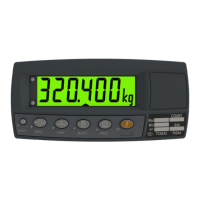Communications Manual Rev 3.10 Software Versions 3.xx
Page 14
003R-618-310
4. Protocol Overview
The instrument contains a number of registers. The indicator is configured by reading and
writing the information stored in these registers. Information such as gross weight is
obtained by reading these registers. The instrument has registers of different types to hold
weights, menu options, etc.
4.1. COMM Message Structure
The messages use ASCII characters. Almost all numeric values are transmitted in
hexadecimal form using uppercase HEX characters (ie. 0 to 9, A to F).
Commands from a Master (typically a PC) to a Slave (typically an Indicator) are of
the form:
Address
Field
Command
Field
Register Id [Optional
Parameter]
xx mm rrrr “:” [ppppp]
Table 2 COMM Command Format
Responses from Slave to Master are of the form:
Address
Field
Command
Field
Register Id Return value
yy mm rrrr “:” vvvvv
Table 3 COMM Response Format
Where:
xx is the Address Field sent to the indicator (Response bit = 0).
yy is the Address Field in the response from the indicator (Response bit = 1).
mm is the Command Field.
rrrr is the Register Id Field.
“:” is the separator between the command header and the parameter or return
value.
ppppp is the optional parameter value sent to the indicator.
vvvvv is the return value from the indicator.
is the two characters <CR><LF> (Carriage-Return, Line-Feed).

